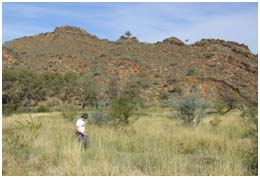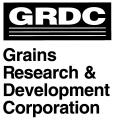Complete
This project discovered whether Australian smuts represent a monophyletic group and what ecological factors shaped the diversity of smut fungi in Australia. It also researched whether the evolution of host plants drove the evolution of the smut fungi. It also looked at whether there are molecular loci that allow for nano-scale diagnostic techniques to distinguish smut species and if there are any morphological synapomorphies within smut fungi that will allow them to be split into clear taxonomic groups.
What is the biosecurity problem?
The biodiversity of smut fungi is immense. Vast numbers of cryptic and intriguing smuts occur naturally in undisturbed ecosystems. Smuts occupy many ecological niches and a close relative, the dandruff fungus Malasezzia, even infects animals. Grasses including crops such as wheat, sugarcane, rice, maize and sorghum are all susceptible to smut infection. Diseased plants become infertile as their flowers or seeds are substituted with masses of black, powdery spores. For some cereal grains, entire harvests can become near worthless with the presence of smut spores. It has been estimated that the introduction of wheat smut (Karnal bunt caused by Tilletia indica) to Australia would cause a $A.1.3 billion sway in the economy through a loss of wheat exports, new import costs and job redundancies.
Over 1,500 smut species are known and we are on the verge of understanding the evolution and resolving the taxonomic issues within the group. Australian smut fungi have been comprehensively qualified and their identification has been revolutionized by an interactive, computerized key (Lucid). However, there is some turmoil within the classification of smut fungi as some genera/groups (in particular the Ustilago/Sporisorium/Macalpinomyces complex) overlap causing confusion with species placement. This is problematic as people refer to the same organism by different names. Phylogenetic analysis of morphology, biogeography and molecular loci may indicate how smut fungi evolved and reveal a more accurate classification system.
The main outputs of this project were to:
- revise smut taxonomy (Ustilago/Sporisorium/Macalpinomyces complex) in a systematic framework
- investigate the reasons for character evolution in smut fungi
- determine the historical biogeography and diversification of Australian smuts
- identify economically important smuts through the nanobead molecular diagnostic platform
The diagnostic tools produced for smut fungi will be a model for the creation and application of nanobead diagnostics for other organisms.
Who are the end users of this research?
AQIS and other quarantine organisations, mycologists, systematists.

STUDENT

Mr Alistair McTaggart
Student CRC60074: Smut Fungi - PhD
alistair.mctaggart@deedi.qld.gov.au
Phone: 07 3896 9598
Read More
PROJECT DETAILS
Complete
Supervisor
Dr Tanya Scharaschkin and Dr James Smith (QUT) and Dr Andrew Geering (QDPI&F)
Supervising Institution
Queensland University of Technology
Term
January 2008 – December 2010
LOCATION
The main goal of this project was to undertake research that will develop technically sound sample/survey methodologies and systems to enhance the ability to capture a wide range of plant health information in an accurate and cost-effective manner both domestically and internationally.
What is the biosecurity problem?
I aimed to create the necessary tools to significantly reduce the amount of human intervention, as required in present systems. The computational techniques will be required to recognise and identified EPPs in real-time on-board automatic insect traps. The use of imaging technologies based upon hyperspectral and UV ranges to develop a statistical and computational framework for the classification and identification of selected EPPs are challenges.
The main outputs of this project were to:
- devlop new, better understanding of shape/image descriptors suitable for spectral imagery specially designed for biosecurity surveillance systems
- create a set of kernel-based, statistical methods that can be used to perform classification of emergency plant pests making use of the descriptors developed in item 1, and
- develop a framework that will permit the extension of the classification methods developed in item 2 to include domain knowledge. This will involve the development of semi-supervised pattern recognition and interactive computer vision methods based upon statistics that are scalable and capable of real-time analysis.
Who are the end-users of this research?
Automatic and continuous monitoring capabilities of ‘smart traps' have a high potential for commercialisation, both nationally and internationally. Such technology will most likely be adopted by state agencies and plant-based industries involved in early warning networks for emergency plant pests to increase efficiency and reduce cost of monitoring early warning insect traps. Outcomes from this project may also be applicable to a range of biosecurity issues such as semi-automated surveillance systems in quarantine facilities, index databases, building of libraries for future reference, etc.
STUDENT
PROJECT DETAILS
Complete
Supervisor
Dr Antonio Robles-Kelly and Dr Jun Zhou (ANU) and Dr Louise Morin (CSIRO Entomology)
Supervising Institution
Australian National University
Term
March 2008 – March 2011
LOCATION
There are hundreds, perhaps thousands, of invasive species that have the potential to arrive and establish in any particular region or country. Identifying which species are more likely than others to invade and establish is extremely difficult, yet the capacity to do so is vitally important to the biosecurity of a nation.
Currently, government agencies consult industry stakeholders and technical experts, as well as published data to generate a pest risk assessment for a particular insect pest. While this can be valuable for many reasons, any estimate of risk is ultimately subjective. An alternative is to use a more quantitative modelling approach to generate more objective estimates of risk. One modelling approach is to utilise a Self Organising Map (SOM), which is a type of artificial neural network.
Research outcomes:
Self organising maps (SOM) are a useful tool for ranking species by their likelihood of establishment. We have tested this tool and found it to be both resilient to significant errors in the distributional data (up to 20%) and very reliable in its predictions of which species will and wont invade a region.
Research implications:
SOM would be a valuable tool to integrate into the current biosecurity practices. It could be used initially to screen a large number of potential invasive species down to a more manageable number. The rankings generated by SOM for this reduced list could then be included in the consultative process currently used to prioritise pest lists.
Acknowledgements:
The project team would like to thank the following government agencies for their gracious support of the project: Department of Agriculture, Fisheries and Forestry – Bureau of Rural Science; Department of Agriculture and Food Western Australia, Department of Primary Industries Victoria; the South Australian Research and Development Institute; New South Wales Department of Primary Industries; Northern Territory Department of Primary Industries, Fisheries and Mines; the Tasmanian Department of Primary Industries and Water; and the Queensland Department of Primary Industries and Fisheries.
We would like to acknowledge the help and advice of the following people and organisations: Richard Mack, Andy Sheppard, Paul De Barro, Matthew Thomas, CAB International, Tak Ikeda, Roger Magarey, Dan Fieselmann, Karl Suiter, Sharyn Taylor, Nadiah Kristensen, Simon Barry, John LaSalle, Marianne Horak, Rolf Oberprieler, Peter Gillespie, Bob Forrester, Alice Wells, Darren Kriticos, Felix Bianchi, Gary Fitt, Roger Shivas, Mike Watts, Greg Baker and Marc Poole.
Thank you very much to CRCNPB’s Delivery and Adoption Program and CSIRO Computational and Simulation Sciences Transformational Capability Platform for their generous support of the Technologies Enhancing Biosecurity Preparedness workshop held at the Rydges Lakeside Canberra Hotel on the 21st May 2009. We particularly thank John Taylor (CSIRO), Cain Roberts (CRCNPB) and Melanie Hay (CRCNPB) for their help in arranging the workshop. We would also like to thank all who participated and helped to make it a success, including Jeanine Baker (DAFF – BRS), Joanne Banyer (ABIN), Mike Cole (OCPPO), Andrew Copp (DEWHA), Daniel Fieselmann (USDA – APHIS), Neil Grant (DAFF – BA), Don Gunusekera (DAFF – ABARE), Takayoshi Ikeda (Lincoln University), Jon Knight (Imperial College London/PRATIQUE), Gwenael Leday (Lincoln University), Simon McKirdy (CRC NPB), Steve McMahon (ABIN), David Newth (CSIRO), Bill Roberts (DAFF – BA), John Sandow (CRC NPB), Andy Sheppard (CSIRO), John Taylor (CSIRO), Sharyn Taylor (PHA), Louise Van Meurs (DAFF – BA).
PROJECT LEADER

Dr David Cook
Project Leader CRC10001: Early Warning Threat Identification
david.cook@agric.wa.gov.au
Phone: 02 6246 4093
Fax: 02 6246 4000
Read More
PROJECT DETAILS
Complete
Term
December 2006 – November 2009
Budget
$764,371 (cash and in-kind support)
PROGRAM DETAILS
LOCATION
CORE CRC PARTICIPANTS
SUPPORTING CRC PARTICIPANTS
Eradication of arthropod harmful plant pest incursions has often relied on destructive technologies such as crop removal and broad spectrum pesticide application. This strategy incurs a significant cost to industry, the environment and the community. Alternative eradication strategies that reduce the economic and social impact need to be developed.
Research outcomes
Eradication technologies were reviewed including, documenting irradiation biology and inherited sterility of Light Brown Apple moth. The competiveness of sterile moths was tested and the integration of eradication technologies was also investigated.
Research implications
Sterile insect technique has an important role as a key part of new age eradication technologies but integration with pheromones and other eradication tools needs further study. which will be conducted in phase two of this project CRC40136: Insect Eradication.
Project team
Max Suckling, Greg Baker, David Williams, Lloyd Stringer, Ian Lacey, Vanessa Mitchell, Alven Soopaya, Amandip Kaur.
Acknowledgements
David Eagling’s contribution as research leader is gratefully acknowledged.
PROJECT LEADER

Mr Bill Woods
Project Leader CRC40024: Insect Eradication (phase one)
bwoods@agric.wa.gov.au
Phone: 08 9368 3962
Fax: 08 9368 3195
Read More
PROJECT DETAILS
Complete
Term
December 2006 – December 2009
Budget
$549,000 (cash and in-kind support)
PROGRAM DETAILS
LOCATION
CORE CRC PARTICIPANTS
CONTRIBUTORS
This project investigated options to overcome the cause of deficient fumigation, sustain the life of phosphine and enable the effective application of new fumigants. It will develop an integrated aeration-fumigation technology for faster, more reliable and sustainable grain disinfestation.
Overall it will develop improvements to the fumigation capability of grain storage facilities, fumigation technologies and practices to better control pest insects and keep Australia's grain export industry free from insect strains resistant to phosphine.
Research outcomes:
- Quantification of each of the phenomena involved in applying fumigants in gas-tight industrial grain stores and demonstrated the significance of each via field trials and mathematical modelling (e.g. sorption, silo breathing, leakage, flow dispersion).
- A data set defining the mortality of representative stored product insects to “interrupted” PH3 doses.
- An extensive data set quantifying phosphine, methyl bromide and ethyl formate sorption by grain.
- A mathematical model defining the kinetics of fumigant sorption by grain.
- A data set defining the intergranular gas flow dispersion coefficients of packed beds of grain.
- A computational fluid dynamics model of fan-forced fumigation based on the significant influences identified with field trials, including industrial scale validation of the fundamental mass transport equation set.
- Simulations of recirculated fumigation in silos.
- Field trial data sets describing phosphine distribution for a recirculated fumigation system in gas-tight silos and losses due to weather influences and grain sorption.
- Evidence based diagnosis of the significant mass transport phenomena that determine the distribution of fumigants in stored grain.
- Performance of a commercial industrial scale fan-forced fumigant dispensing system designed for implementation in large scale grain stores, with a focus on aeration-cooled silos (collaborative effort with manufacturer).
- A commercial prototype system combining fan-forced phosphine fumigation with aeration-cooling in large silos (>1000tonne) addresses the problems identified and is being traded by an industry technology supplier (Kotzur).
Research implications:
- The roles of the factors affecting fumigant doses within fan-forced fumigated grain stores (mortality, distribution, sorption, leakage) were diagnosed with laboratory data and modelling and validated with field trials. These results identified the main causes of fumigation failure and resistance selection with this fumigation system.
- The experimentally determined data sets and mathematical models act as ongoing contributions to the science and technology of grain storage and fumigation which are listed here as follows.
- A data set defining the mortality of representative stored product insects to “interrupted” PH3 doses.
- An extensive data set quantifying phosphine, methyl bromide and ethyl formate sorption by grain.
- A mathematical model defining the kinetics of fumigant sorption by grain.
- A data set defining the intergranular gas flow dispersion coefficients of packed beds of grain.
- A computational fluid dynamics model of fan-forced fumigation based on the significant influences identified with field trials, including industrial scale validation of the fundamental mass transport equation set.
- Field trial data sets describing phosphine distribution for a recirculated fumigation system in gas-tight silos and losses due to weather influences and grain sorption.
- Evidence based diagnosis of the significant mass transport phenomena that determine the distribution of fumigants in stored grain.
- A prototype commercial industrial scale fan-forced fumigant dispensing system designed for implementation in large scale grain stores, with a focus on aeration-cooled silos (collaborative effort with manufacturer) was developed and its performance defined.
- The research results of this project in fan-forced fumigated stores illustrate that selection of PH3 resistant strains of insects is predominantly affected by fumigant distribution versus sorption, and the analysis approach of this work should be continued for non fan-forced grain fumigation systems.
Acknowledgements:
The following collaborators are gratefully acknowledged for the contribution to the success of this project.
- Co-operative Bulk Handling of WA; Ernie Kostas, Graeme George, Alan Bone, Aaron Rhodes, Dean Scott, Phil Taylor.
- CSIRO Ecosystem Sciences; Stephen Beckett, Tracy Willis, Tiffany Cripps, Aaron Barrett, Ben Padovan, Julie Cassells
- GrainCorp Operations Pty Ltd; Matthew Head, Robyn Reid, Warren Bremer, Bruce Cole
- Kotzur Engineering; Andrew Kotzur, Murray Collis, Malcom Bruce, Kevin Hunt, John Bickerton
- University of WA; Professor Liang Cheng, Dr Ming Zhao, Wei He, Dr Pat Morgan
- Viterra SA; Greg Hopkins, Steve Buick, Geoff Masters, Merv Crossman, Grant Haines
PROJECT LEADER
Mr James Darby
Project Leader CRC50059: Fumigation Technology
james.darby@csiro.au
Phone: 02 6246 4197
Fax: 02 6246 4202
Read More
PROJECT DETAILS
Complete
Term
July 2007 – August 2009
Budget
$966,324 (cash and in-kind support)
PROGRAM DETAILS
LOCATION
Currently biosecurity prediction is highly uncertain. Plant industries need more confidence in planning for biosecurity investments. The current system depends on expert opinion on a number of questions. While this may be the best available system to prioritise threats at present, it is well known that opinion is susceptible to bias and possibly misleading prioritisation.
Research outcomes:
Our research showed that multi-criteria decision analysis is an effective vehicle for the communication of results of economic analyses, technical scientific information and personal experiences to groups of decision-makers. These decision makers may be deciding on how much industry money to invest in species-specific research and development activities, government agencies forming part of the biosecurity continuum, industry and regional cooperative institutions, or local governments allocating money to pest and disease control activities. If supported by a transparent, interactive tool revealing group and individual preferences, experts capable of conveying their knowledge in a clear fashion and adequate technical information about pests, the technique we have developed is a highly effective decision-facilitation device.
In a trial setting it has been successfully used to prioritise a diverse list of pests and diseases affecting different industries. An interesting finding of our research is that introducing information about uncertainties in future pest impact scenarios does not necessarily have a significant impact on pest prioritisation. While the use of quantitative models to provide effective expert testimony on the market impacts of pests proved very successful, the relative uncertainty/quality of that information appeared to have little effect on decision-maker priorities. This being the case, there may be scope to further simplify the deliberative process to make group decision facilitation more rapid.
Sample of Threat Data documents:
For a full list, please see the below Final Report.
Research implications:
The range of possible impacts society may face in the future as a result of pest and disease incursions should be taken account of when planning risk mitigation activities. For instance, industry and government research and development programs targeted towards future threats should take into account forgone opportunities to invest in other activities that could potentially produce large benefits for the community. This is particularly true of invasive species that have both cultivated and wild native hosts since an outbreak can produce both market and non-market impacts. If only the market impacts are taken into account during industry and government strategic plans, there is a danger species with environmental and social impacts may be under-funded. The implications of this research project for all members of the biosecurity continuum are that practical tools have been developed to enable both market and non-market impacts of pests and diseases to be accounted for when planning for the future. To be most effective they require diverse groups coming together and talk about specific threats and a willingness to understand alternative points of view and joint approaches to risk mitigation and management.
Acknowledgements:
The Enhanced Biosecurity Planning Tools project team would like to acknowledge the role members of our Expert Reference Group played in shaping the project. This group was a valuable resource throughout, and we thank Tony Russell (Apple and Pear Australia Ltd.), Nicky Bresolin (Plant Health Australia), Mike Cole (DAFF-OCCPO), Wendy Proctor (CSIRO Sustainable Ecosystems), Andy Sheppard (CSIRO Entomology), David Dall (RIRDC), Kim James (HAL), Rob Duthie (HAL/Kalang Consultancy Services), Debra Riddell (DAFF-BRS), Jane Fisher (RIRDC) and Ryan Wilson (PHA) for their time, insight, thoughts and ideas.
Thank you very much to Cain Roberts and the Cooperative Research Centre for National Plant Biosecurity’s Delivery and Adoption Program for their generous support of the Pest Risk Prioritisation Stakeholder Workshop held at the Rydges Lakeside Canberra Hotel on the 6-7 May 2009. Thank you also to all who participated in this workshop and helped to make it a tremendous success, including Nicole Bresolin (PHA), Jason Cappello (NSW Farmers Association), Rochelle Christian (Bureau of Rural Sciences), Mike Cole (DAFF), David Dall (RIRDC), Peter Darley (NSW Farmers Association), Paul DeBarro (CSIRO Entomology/CRC NPB), Ron Gordon (Batlow Fruit Co-op.), Kim James (Horticulture Australia Ltd.), Trevor Ranford (Apple and Pear Australia Ltd.), Tony Russell (Apple and Pear Australia Ltd.), Bill Rye (Cropwatch), Rien Silverstein (Pear Grower), Andrew Tomkins (Department of Regional Development, Primary Industries, Fisheries & Resources) and Ian Warren (Department of Environment Water Heritage and Arts).
PROJECT LEADER

Dr David Cook
Project Leader CRC10010: Enhanced Risk Analysis Tools
david.cook@agric.wa.gov.au
Phone: 02 6246 4093
Fax: 02 6246 4000
Read More
PROJECT DETAILS
Complete
Term
July 2006 - November 2009
Budget
$1,312,099 (cash and in-kind support)













